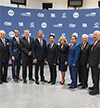Energy Availability & Costs: Impacted by Reliability and “Going Green”
Energy typically falls in the top site-selection factors for any project. The greater a project’s consumption of energy, the more important the availability and total cost of energy becomes in the final selection decision. The respondents to Area Development’s 26th Annual Corporate Survey (Published Winter 2012) ranked energy availability and costs seventh among the factors, with 84. 8 percent considering this factor as “very important” or “important.”
November 2012
Economic development incentives, low risk of natural disasters, property tax rates, and occupancy/construction costs typically are equally important in projects where energy availability and cost rank highly, according to Larry Gigerich, managing director for Ginovus in Indianapolis, Indiana. “For these types of projects, the ability to lower project and operating costs, along with a low risk of business disruption, are vital,” says Gigerich. Industries that consume high amounts of electricity include food processing, automotive, and data centers.
Data Centers
One of the biggest cost drivers for data centers is utility power (including any required substations or transmission fees). Cooling IT equipment also consumes high amounts of energy (this can be mitigated somewhat by building data centers in locations that have cool, dry climates).
As an example, if a data center consumes 2,000 kilowatts at a rate of $0.10/kilowatt hour, energy consumption will total about $1.8 million annually. “With those kinds of costs, a reduction of only $0.01/kilowatt hour will make a big difference in the bottom line,” says Buzz Canup, president of Canup & Associates in Greenville, South Carolina.
As a result, data centers are locating in regions that have the most affordable power, including hydroelectric. The Pacific Northwest, especially Oregon, is attracting data centers because of its low rates.
Reliability is another factor. “If a company needs 99.9 percent availability it will require a redundant feed,” adds Canup. Infrastructure for dual feeds can often be negotiated with local communities and their utility providers, who are eager to work with long-term, high-energy users. Discounted rates for off-peak usage and green energy components can be negotiated as well.
Ginovus assisted Oracle Corporation in the location of its largest data center to a suburb of Salt Lake City, Utah. The three key project drivers were energy cost and availability, property tax rates, and economic development incentives. The finalists for the projects were Salt Lake City, Utah, and Boise, Idaho.
“Rocky Mountain Power offered very competitive electric rates for our client,” says Gigerich. “Local property tax incentives to lower tax liability and cover some portion of land acquisition costs, along with state tax credits, were key factors in lowering project and operating costs. Given the fact that electric power and property taxes are the two key operating costs for all data center projects, the cost of power and economic development incentives were key to the final decision.”
Going Green
More companies are interested in developing a green footprint and using renewable, carbon-free energy for their facilities. Even though green energy can be an extra cost factor up front (for example, solar panels on warehouse roofs in the Southwest), it does eventually bring rates down and improves the company’s image.
“Sometimes the driver is not so much cost but growing the value of ‘green’ in a company’s brand,” says John Boyd, principal with the Boyd Company in Princeton, New Jersey. “Green brings coveted social and public relations value, which appeals to the company’s executive suite and corporate/investor relations department, beyond the site selection/real estate team with whom we interact.”
Boyd cites a good example of “green envy” as part of the recent decision of BMW to locate a major composites plant in central Washington State near Quincy, where Dell, Microsoft, Intuit, and Yahoo have also recently located major energy-hungry data centers. “Quincy offers some of the lowest-cost green energy in the U.S. powered by the hydro plants on the Columbia River,” says Boyd.
Also along green lines, the impending implementation of California’s controversial cap-and-trade program — which has been estimated to cost industry more than $1.2 billion — is already having a negative impact on corporate investment and jobs. Industries hit especially hard by these new regulations include agriculture and food and beverage processing, which are critical industries for California’s Central Valley.
Boyd sums up: “Very recently, Camden, New Jersey-based Campbell Soups announced the closing of its iconic vegetable processing plant in Sacramento and the loss of some 700 jobs. We fully expect other food and beverage processing operations in California to reassess their investments and look at alternative sites in places like Arizona, Texas (a destination of Campbell’s Sacramento operations), the Willamette Valley in Oregon, central Washington State, and other lower-cost and energy-friendly options in the Midwest. We are currently doing feasibility cost analyses for several snack foods and soft drink/energy drink companies that are also concerned about the impact of cap-and-trade on the bottom line of their California operations.”
Project Announcements
EPC-Columbia Plans Fremont, Ohio, Manufacturing Operations
11/05/2025
Aclara Resources Plans Calcasieu Parish, Louisiana, Heavy Rare Earth Separation Operations
11/04/2025
KCG Engineering Group Plans Chesapeake, Virginia, Operations
11/04/2025
Morin Establishes Little Rock, Arkansas, Operations
11/03/2025
Provalus Plans West Plains, Missouri, Operations
11/01/2025
Eos Energy Enterprises Expands Allegheny County, Pennsylvania, Operations
11/01/2025
Most Read
-
2025’s Top States for Business: How the Winners Are Outpacing the Rest
Q3 2025
-
The Compliance Reckoning Is Here
Q3 2025
-
Around the Horn: Data Center Supply Chains — What's Next?
Q3 2025
-
How Consumer Trends Are Reshaping Food Facilities
Q3 2025
-
First Person: Filter King’s Expansion Playbook
Q3 2025
-
Rethinking Auto Site Strategy in the Age of Tariffs and Powertrain Shifts
Q3 2025
-
Lead with Facts, Land the Deal
Q3 2025



